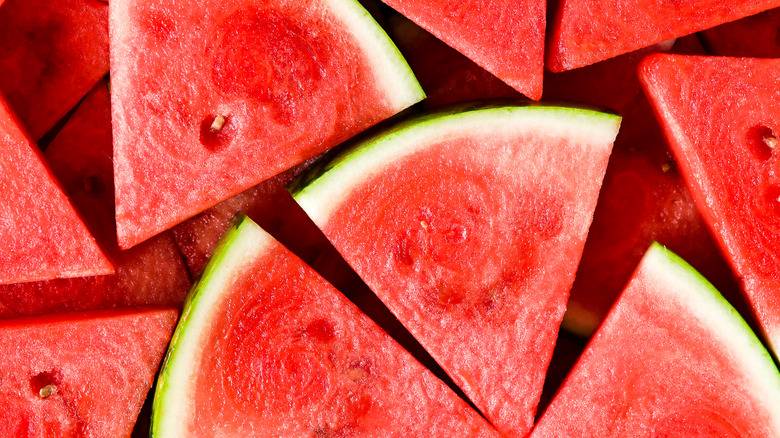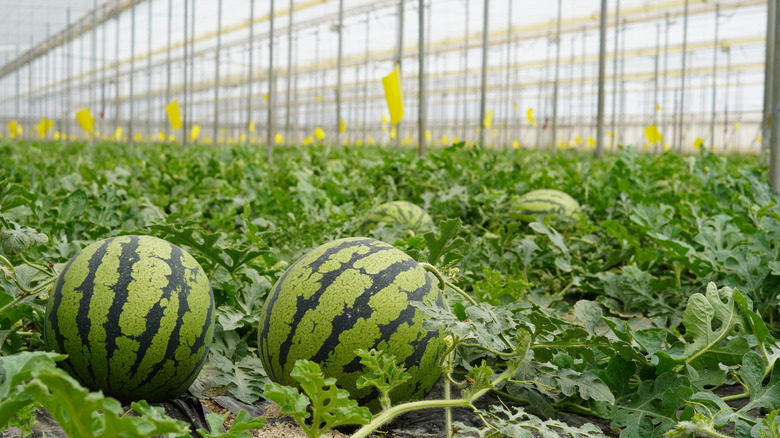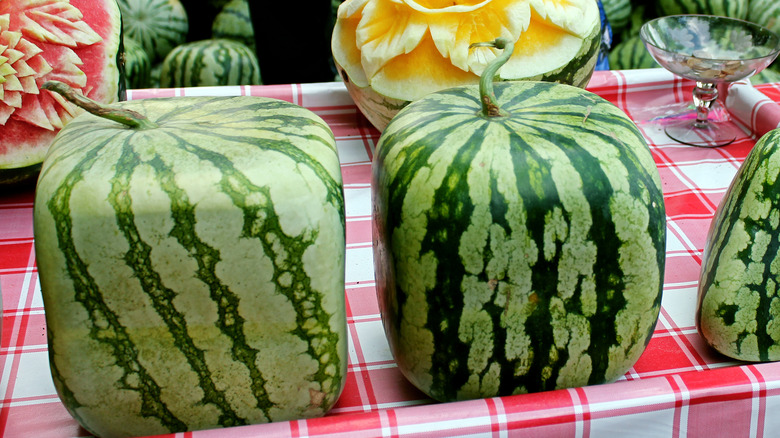The Science Behind Growing Seedless Watermelons
Synonymous with picnics, barbecues, and warm-weather snacking, the watermelon is a staple summer refreshment. The fruit, made of 92% water, hydrates as well as nourishes (via Live Science). In fact, "Watermelons are natural sources for water, vitamins, and certain nutrients. Studies have found athletes can eat watermelon during sporting events to rehydrate, as well as improve circulation, keep electrolytes in balance and boost performance," says Gilbert Miller in the Augusta Chronicle. Yet many often wonder how humans have improved this near-perfect fruit by removing the pesky black seeds.
While seedless watermelons may seem like agricultural wizardry, creating a seedless watermelon is straightforward and doesn't require genetic modification. Farmers use simple cross-breeding practices to produce the seedless fruit.
Creating a seedless watermelon is akin to creating a mule, breeding two incompatible species to produce a sterile hybrid. The seedless watermelon is essentially a sterile fruit, unable to seed.
If you're hoping to grow your own seedless watermelons, your best bet is to buy seeds already cross-bred, since making a seedless watermelon out of a standard watermelon requires prior knowledge of agricultural sciences. Once you've planted the seeds, the University of Nebraska, reminds aspiring watermelon growers that they are warm-weather fruit and recommends a light potting mix and irrigation.
It comes down to genetics
According to Laurie Hodges at The University of Nebraska, "a basic understanding of genetics is helpful to understand how a seedless watermelon is created." But don't worry, you don't need to pull out your high school biology books to understand how seedless watermelons are made. Let's break it down.
The process of creating a seedless watermelon begins with chromosomes. Chromosomes carry genetic information. Essentially, they provide the instructions for how every living thing, including watermelons, looks and operates (via watermelon). Chromosomes play a key role in determining whether a plant is fertile (seeded) or sterile (seedless).
Standard watermelons are diploid, meaning they have two sets of chromosomes. The crossbreeding process begins by treating a seeded watermelon with colchicine, a chemical that prompts the melon's chromosomes to duplicate, creating a tetraploid, a melon with four sets of chromosomes, reports Mental Floss.
The diploid pollinates the tetraploid, creating a triploid melon with three sets of chromosomes. Mental Floss explains, the new melon will grow just like a standard melon, but it won't be able to reproduce, which means the seeds won't develop. Thus, we have the seedless watermelon enjoyed with ease at picnics and summer parties.
Watermelon innovations around the globe
Seedless watermelons originated in Japan at Kyoto University over 50 years ago. The scientist and professor H. Kirata is to thank for inventing them, according to Augusta Chronicle. And they're not the only watermelon innovation coming out of Japan. For over 40 years, Japanese farmers have produced cube-shaped watermelons, explains Mental Floss. Originally, the right-angled melons were designed for better stacking during refrigeration but now are novelty items. Some watermelons can even be shaped into hearts, pyramids, or human faces.
The watermelon fanaticism continues in the US as well. Mental Floss reports that the largest documented watermelon was grown by Chris Kent, of Sevierville, Tennessee, in 2013, weighing in at 350.5 lbs. The fruit became officially recognized in 2007 by the Oklahoma State Senate, who named the watermelon its state vegetable (watermelons have been classified as both vegetables and fruit, depending on who you ask, says HuffPost). And the U.S. is home to the sweet Bradford, an heirloom variety of watermelon out of South Carolina that the Bradford family has preserved for over one hundred years.


